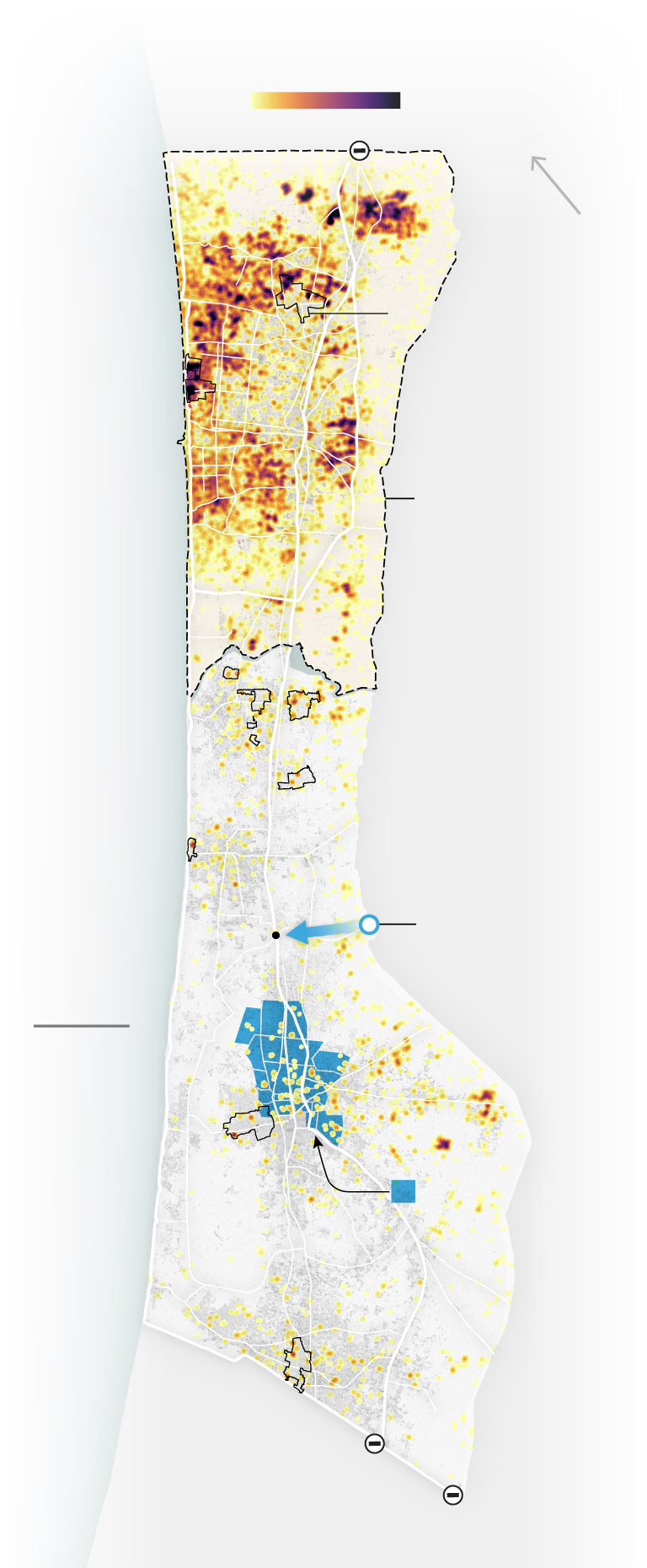A focal point of the operations Monday was Gaza’s Salah al-Din Road, which Israel had previously designated as an evacuation route for civilians fleeing from the north to the south. The Israel Defense Forces, for the first time, announced Monday that a segment of the road, north of Khan Younis, was a “battlefield” and that residents should no longer approach it.
The IDF identified “bypass” roads it said residents should travel on instead, adding to the thicket of evacuation orders Israel has issued in recent days that it says are aimed at reducing civilian casualties. But aid groups have warned the directives are becoming impossible to navigate, while Palestinians in Gaza say the guidance is of little use in a place where most everywhere is filled with peril.
Late on Monday, the Palestine Red Crescent Society said that it had lost contact with its medical teams in Gaza, after the main telephone and internet provider, Paltel, said all telecommunications services were cut.
“The level of human suffering is intolerable,” Mirjana Spoljaric Egger, the president of the International Committee of the Red Cross, said in a statement Monday as she visited Gaza. “It is unacceptable that civilians have no safe place to go in Gaza, and with a military siege in place there is also no adequate humanitarian response currently possible.”
Since a week-long humanitarian pause ended Friday, with Hamas and Israel blaming each other for its collapse, Israel has “entered a new phase in our war against Hamas,” Rear Adm. Daniel Hagari, an Israeli military spokesman, said Monday.
“We pursued them in northern Gaza; we are now pursuing them in southern Gaza, too,” Hagari said in a recorded press statement. “We will operate in maximum force against Hamas terrorists and infrastructure while minimizing harm to the civilians that Hamas places around them as shields.”
Separately, the Israeli army announced in a statement Monday that it had targeted hundreds of locations in Gaza by ground, air and sea, including a weapons storage facility and a vehicle containing mortar shells, missiles and other weapons. The statement did not say when the strikes occurred.
Hundreds of Palestinians have been killed by Israeli strikes since Friday, according to the Gaza Health Ministry, which said Monday that at least 15,899 people had been killed since Oct. 7, when Hamas launched a deadly attack on Israel that killed at least 1,200 people.
Despite the growing death toll, the White House said Monday that it was “too soon” to judge whether Israel was doing enough to limit civilian casualties as its forces pushed into southern Gaza.
“Over the course of the weekend, we’ve seen basically 48 to 72 hours of activity. So it’s too soon for me to sit here and tell you that I’m going to pass some comprehensive judgment,” White House national security adviser Jake Sullivan told reporters at a briefing Monday.
But as the fighting intensified across Gaza, the dangers for civilians accumulated, including along Salah al-Din Road, the main thoroughfare linking the northern and southern parts of the enclave.
Intense shelling in the area started Friday, soon after the pause ended, according to Hani Abu Mustafa, 39, who lives near the road north of Khan Younis. “We were being bombed in such a devastating and frightening way by F-16 planes that we thought it would be our last night,” he said.
By Saturday morning, large numbers of residents were fleeing, after the Israeli military dropped leaflets warning them to evacuate, he said.
Abu Mustafa’s family had been loath to leave. They stayed in their house throughout the last few weeks, wary of the “bitterness” that awaited them in evacuation shelters, he said. They only left their home, he added, when he saw Israeli tanks with his own eyes on Saturday morning.
“We did not have time to carry any of our personal belongings,” he said. On Sunday, he said, “We received news from neighbors who live near our house that the army had turned it into a military barracks, and was shooting at passersby on Salah al-Din Street.”
Witnesses said Monday that Israel had established a checkpoint at the intersection of Al-Matahen and Salah al-Din streets. Israeli forces previously operated a checkpoint in the same area when they occupied Gaza before withdrawing in 2005.
Satellite images, taken Sunday by Planet Labs, show vehicle tracks beginning at the Gaza-Israel border and continuing about 2.5 miles west into the Strip. The tracks end shortly after cutting Salah al-Din Road.
The vehicles are parked about 1.7 miles north of the municipal boundary of Khan Younis, the largest city in Gaza’s south and now home to hundreds of thousands of Palestinians displaced by Israel’s invasion in the north.
Sondos Daloul, 25, who is staying in a school with her family on Salah al-Din Road in the Deir al-Balah area, said tanks had taken up positions in the area over the last few days. Artillery shelling had wounded people sheltering there, she said.
More than 80 percent of Gaza’s population has already been displaced, according to figures released Monday by the U.N. agency for Palestinian refugees, UNRWA. Overcrowded homes, hospitals, shelters and tent camps have also helped spread disease and conditions such as diarrhea and skin infections, the United Nations says.

Density of damage based
on satellite imagery
The Israeli
Defense Forces
issued an
evacuation
order
for northern
Gaza on
Oct. 13.
Witnesses
report seeing
Israeli tanks
entering Gaza
at Kissufim
Gate, moving
toward
Matahin
Junction.
On Monday
the IDF told
residents
in these areas
to evacuate
to areas.
Kerem Shalom
commercial
crossing

Density of damage based on satellite imagery
The Israeli Defense
Forces issued an
evacuation order
for northern Gaza
on Oct. 13.
Witnesses report
seeing Israeli tanks
entering southern
Gaza at Kissufim
Gate, moving
toward Matahin
Junction
On Monday the
IDF told residents
in these areas
to evacuate
to areas south
and east.
Kerem Shalom
commercial
crossing

Density of damage based on satellite imagery
The Israeli Defense
Forces issued an
evacuation order
for northern Gaza
on Oct. 13.
Witnesses report seeing Israeli
tanks entering southern Gaza
at Kissufim Gate, moving toward
Matahin Junction
On Monday the IDF
told residents
in these areas
to evacuate to
areas south and
east.
Kerem Shalom
commercial crossing
Israeli forces “have actually taken the quite unusual step for a modern military and identified precisely the area that they intend to have ground maneuver,” Sullivan said of the evacuation notices. “And they have asked the people in that area to move out.”
But the instructions issued Monday did not give specific directions for civilians heading south from Gaza City and northern Gaza, areas that Israeli forces largely cut off since launching ground operations in late October.
Nir Dinar, an IDF spokesman, said Monday that “there is still an open corridor from the north to the south” along Gaza’s coastal road, west of Salah al-Din, which he said was open Monday from 11 a.m. to 5 p.m.
He said civilians were notified of the route through recordings, leaflets and text messages, but added that no recordings were issued Monday and did not immediately respond to a request for copies of text messages and leaflets.
Muhammad al-Natour, 42, a displaced Gazan who is staying north of Khan Younis near Salah al-Din Road, said he received Israeli evacuation notices: a call to the owner of the house where he was staying, demanding they leave, and leaflets dropped from planes, telling them to go to Rafah, on the border with Egypt.
His family complied with the evacuation orders, moving west, away from the army. “If military operations extend to this area, we may suddenly be displaced for a third time,” he said.
Harb reported from London, Fahim from Beirut and Berger from Jerusalem. Cate Brown in Washington, Heba Farouk Mahfouz in Cairo and Evan Hill in New York contributed to this report.
Credit:
1: https://www.washingtonpost.com/world/2023/12/04/israel-gaza-war-south-khan-younis/
The Mention Sources Can Contact is to remove/Changing this articles
